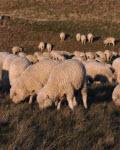Many digital printers and academics, when broached about the subject of digitally printed wool fabrics and garments, had already placed this topic in the ‘too-hard basket’ and had moved on to other things.
Being based in a country that claims to produce the world’s best wool fibre prompted New Zealand’s Auckland University of Technology’s Textile and Design Lab (TDL) to pursue the idea of digitally printed wool with more vigour than most, in an effort to prove or disprove its viability.
The TDL supports both AUT and external students, as well as working with commercial partners on product development, prototyping, sampling and small-scale production projects. The lab has been digitally printing knitwear and fabrics for nearly 7 years and, while much of the demand for its printed fabrics has been for silk and cellulosic materials, it has seen an increase in demand for digitally printed merino wool and merino blended knitwear, as well as single jersey merino fabrics.
The lab’s first sortie into digitally printed merino fabric was in 2007, when it was approached by Icebreaker to help their design team develop some prototype prints for a new range of base-layer garments. The attraction of using digital printing for this project meant the client could circumvent the long-winded development process associated with screenprinting and take advantage of the quick turnaround time afforded by the lab’s digital printer. Strike-offs to the client’s colour palette were able to be shipped within a matter of days.
However, staff at the lab were concerned about three specific issues that continued to manifest themselves when digitally printing wool fabrics and garments: firstly, the degree of variation in dye up-take between the raw materials it was printing; secondly, the tendency for solid colours to appear mottled; and finally, the degree of cross-staining that occurred no matter how thorough the wash-off process.
When digitally printing clients’ knitwear, the lab has little control over where the yarn is sourced, so routine test printing of each lot has become standard practice. Fabrics, on the other hand, are sourced directly by the lab and, after extensive trials, it has settled on locally produced chlorinated shrink-resist and whitened knitted merino wool fabrics from Levana Textiles and Designer Textiles, and natural woven merino fabrics that were developed in New Zealand and now manufactured globally.
The bleaching process applied to the knit fabrics increases the affinity for the reactive dye applied by the lab’s Shima Seiki flatbed printer, thereby reducing the amount of residual dye in the wash bath. According to a consultant dyeing-and-finishing expert who has worked with the lab, the wash fastness of reactive dyes on shrink-resist merino fabrics is superior to that of acid dyes. The whitening process is also more conducive to achieving more vibrant colours.
The woven wool fabrics that have been adopted are light-weight worsted spun merino fabrics that have been mechanically finished to allow machine washability. In spite of the natural colour of these substrates, strong vibrant colours can still be attained.
In 2010 the lab acquired some internal R&D funding that enabled it to contract an experienced wool-textile chemist to advise and help formulate new wet-finishing recipes to overcome the problem of cross-staining. At the same time, it acquired a larger commercial-sized washing machine that facilitated increased water to fabric ratio, a major contributory factor in overcoming colour transfer problems.
Achieving the right wash-bath conditions for wet finishing wool fabrics and garments was accomplished by trial and error until the optimum pH level was attained. The lab introduced a 2-stage gentle-action wash cycle, which involved increasing the pH level in the first wash cycle, and this significantly reduced the propensity for loose dye to adhere to the fabric. A liquid soaping agent was introduced into the second wash cycle before rinsing and hydro extraction.
Tumble drying the fabric was deemed partially responsible for disturbing the surface fibres, thereby contributing to the mottling effect, and was eliminated from the lab’s finishing process in favour of open-width tunnel drying.